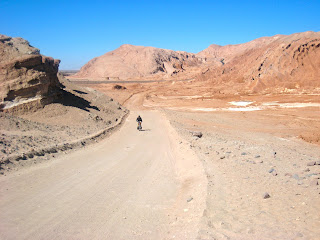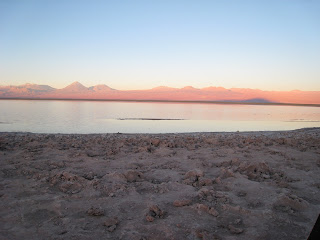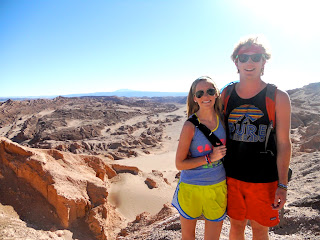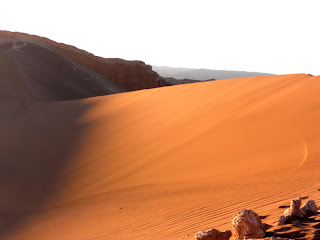As a dedication to Chile's most beloved Pablo Neruda, I have stolen his go-to title for anything that's made him think nostalgically about his life in his patria, his home country. I have decided to dedicate a blog to an experience that has given me my own, unique memories of this country, despite the fact that it has emptied my wallet and required collective hours of waiting alone on a sidewalk as the only blonde amongst dozens of morenos these past three months. My time in Chile would never have been the same without...
colectivos (shared taxis).
I must first preface this entry with the fact that my unique living situation requires me to take colectivos more often than the others in my program. I somehow ended up in the steep, hilly, and isolated neighborhood of Recreo, with winding roads and random back alleys appearing out of nowhere. Initially on this trip, I thought I'd never be able to find my way around, much less leave the place and visit my friends who live on an easy-to-understand, numbered grid of streets. My host family began teaching me how to get myself from place to place my driving me around in their car or going on colectivos with me. On the other side of town, my friends were learning how to take the micros, or buses, which at times seem much easier to catch and can be a great deal cheaper. Unfortunately for me, the buses didn't run through my neighborhood and even if I did want to take one, it required walking 20 minutes just to get down to the normal streets and taking a bus no one showed me how to use yet. I had no idea where the blue, green, and red buses went with millions of signs covering every window, and my friends seemed to be pros in no time. This made for an interesting first month, as the rest of the group waited for me to frantically flag down a colectivo so they could file onto the next bus coming every 30 seconds. I also started to notice that my allotted spending money every month was going towards nothing but transportation, spending $650 Chilean pesos (around $1.30 US) each way between my neighborhood and where I take classes (whereas my friends would only pay around $250). That doesn't sound too bad, does it? Try going to school and back home for lunch, back to school, back home, doing something at night, buying drinks, and getting a radiotaxi (actual taxi) home. I could easily be spending $20 in one day just trying to get around.
With this as what seemed to be my only option, I started becoming more accustomed to the ways of the colectivo. I knew the signals of how to flag one down, the signs on top of each car and what areas of town they signified, and how much each trip would cost me. I learned which seat of the car to sit in depending on the hour, the location, and other passengers, and the etiquette of how to interact with the driver. It almost felt as if I were relearning how to socially interact with human beings, making forced gestures and movements and uncomfortably asking questions I may not understand the answers to.
Interacting within the colectivo has been the most memorable part. Some drivers choose to not say a word to the people they're carting around, except to ask where they need to go and how much each person owes. Other drivers spot my blonde hair and 40-year-old woman J. Crew cardigans and choose to speak to everyone but me, assuming I don't speak Spanish or won't be able to hold a conversation, although I already made it into the car by asking "Are you going to Recreo? Please drop me off at Calle ___. How much will that cost? Here you go, thank you. You can drop me off at this intersection if that's better." Others choose to take advantage of my gringa status and ask me all about myself, wondering about my time here, my opinion of Chile, what I'm studying, what I think of the student strikes, or what I'm doing that night. One man ended up picking me up repeatedly and always needing to take me to the same place, and after a couple times assumed where I needed to go and offered to drop me off right in front of my friend's house instead of on the busy street (I don't know if I should be creeped out that he remembers exactly where I need to go or that he knows my friend Kristin's address!). Another chofer, or driver, offered to have me shadow his daughter who just finished school to become an oral surgeon, after telling him I was studying dentistry. One driver was telling me about the years he lived in the United States working with "clonas" and animals, such as tigers and bears. It was really hard to understand this mumbly old guy and I kept assuming he worked in a lab cloning animals. After 20 minutes of driving around and repeating the word "clooonaaaas" in between the two of us, I figured out the guy worked for the Ringling Brothers Circus! He also didn't train any cool animals, but sold concessions... his misleading job description had me laughing so hard I could barely get out of the colectivo.
Other drivers get a liiiittle too creepy for my liking, telling me I look like a Barbie, asking where they can buy one, or calling me their future Lolita. Sorry Vladimir Nabokov, but you and the rest of the creepy 40 year old taxi drivers in your generation need to back off! What is with this country? Of course, no man in Chile understands the word "no," so men will purposefully veer from their normal route to pick me up (knowing I'll be waiting for 30 minutes for the right colectivo), even managing to U-turn on a congested street just to pick me up. Others ask for my phone number, Facebook information, and ask to go out for dinner, and have even managed to find me online and send me messages. One driver always knows I'm waiting for a ride near where I take classes, always makes sure to drive by at the same time, only to ask for a kiss when he drops me off or screams "I LOVE YOU!" when I get out of the car. Despite going over my piropo (compliments/cat calls) quota for the day when taking these cars home, they've given me an insight into how polite, curious, or machista some Chileans can be.
My dear relationship with the colectivo came to a sudden halt when I realized the efficiency of taking the newer, cleaner, less crowded, and cheaper metro. My neighborhood has its own stop along the metro route, letting me easily go to the neighboring town of Valparaíso or to the stop right in front of where I take classes, deep into Viña. I also manage to save almost $600 Chilean pesos each way to school, paying $85 (around $0.17 US). Instead of dealing with people or worrying about carrying the correct amount of change, I load a pre-paid card and swipe it every time I enter the metro, reaping the amazing benefits of a student discount that comes along with my enrollment here. I managed to save so much more money this way until I LOST my metro card over the weekend...forcing me to start taking colectivo rides again from the creepy Lolita man. While I have probably had more creepy moments than not in these shared taxis, I will never forget my morning rides to class with the same few men who have made me laugh and made me consider lying about what intersection I live on.
So, here's to you, Chilean colectivos, and here's a big thank you for helping me understand more about the culture with every ride.
Wednesday, October 19, 2011
Wednesday, October 5, 2011
Spring Break in the Desert - San Pedro de Atacama
I think a lot of people back home forget that down here, on the other side of the equator, we are in the exact opposite seasons. I left in July, amidst Topeka's unforgiving heat and humidity, and came down in a giant Northface jacket and leather boots, seeing my breath in the air every time I talked. When the weather finally permitted lighter jackets and opened-toed shoes, our university gave us 10 days off as spring started.
Originally I thought that 10 days would allow for traveling all over the continent, seeing Machu Picchu, visiting my friends in Buenos Aires, or traveling to the tip of South America, where I've heard you can see Antarctica (someone fact check me on that, please). When my group of close friends from Denver decided we should go up to the Atacama Desert, the driest desert on Earth located in northern Chile, for a week I wasn't too sure. However, it was one of the best times I've had abroad thus far.
The distance between Viña del Mar to San Pedro doesn't seem too bad when looking at it on a map. We booked a flight that would last around 1 hour and 45 minutes, and assuming "that's how long it takes to fly from Denver to Kansas City!" of course I was naive enough to think it was fine to drive. Wrong. After taking a bus for two hours from Viña to Santiago's bus station, a bus from the station to the airport, flying from Santiago to Calama, taking another two-hour bus ride to San Pedro, and then taking a car from the bus station to our house, we found out that was the easy way to get there. Google maps says if we would've have driven it would have lasted over 24 hours:
Getting into town was a whirlwind of travel companies, restaurants, and shops to buy souvenirs. Every road was made of dirt, as cars driving buy would leave a cloud of dust that blended in with every building. Even nice hotels or restaurants looked like mud shacks on the outside. We were consistently bugged by tour companies on our walk, and we had lots of ideas for excursions in mind after hearing about a group of DU students going to San Pedro last year. However we wanted to try our hardest to find the best deal amongst dozens of companies offering the same trips. We finally decided to book all of our trips with one company, which caved in to our pleas and gave us discounts for booking so much with them (plus, I won't complain that some of their excursions included the occasional pisco sour or meal!).
Our first day of excursions started off with a private horseback ride to the ruins of Quitor. Our private guide took us on a route we did not expect - with no route at all! We rode up mountains and in open valleys with huge rock structures surrounding us, following no path but taking pictures of the amazing sites we couldn't believe we were seeing. I can't even explain it in words. Although the pictures don't do it justice, a few are below:
I definitely must give some credit to Kristin Van Horn for some of the photos above. My camera died about 1/2 way through the trip and needless to say I wasn't a happy camper.
Thanks for reading!
Originally I thought that 10 days would allow for traveling all over the continent, seeing Machu Picchu, visiting my friends in Buenos Aires, or traveling to the tip of South America, where I've heard you can see Antarctica (someone fact check me on that, please). When my group of close friends from Denver decided we should go up to the Atacama Desert, the driest desert on Earth located in northern Chile, for a week I wasn't too sure. However, it was one of the best times I've had abroad thus far.
The distance between Viña del Mar to San Pedro doesn't seem too bad when looking at it on a map. We booked a flight that would last around 1 hour and 45 minutes, and assuming "that's how long it takes to fly from Denver to Kansas City!" of course I was naive enough to think it was fine to drive. Wrong. After taking a bus for two hours from Viña to Santiago's bus station, a bus from the station to the airport, flying from Santiago to Calama, taking another two-hour bus ride to San Pedro, and then taking a car from the bus station to our house, we found out that was the easy way to get there. Google maps says if we would've have driven it would have lasted over 24 hours:
Our group of six decided to take the untraditional route and rent a house together instead of staying in a hostel. Our house was about a 10 minute walk to the center of town, with a bed for each of us and a kitchen stocked with enough to do our best cooking. We'd often make quite a show at the tiny markets, buying entire cartons of 30 eggs, huge amounts of meat, cheese, and bread, and spending $80 all together on our first round of food (this seemed like a pretty hefty number to be dropping to the store owners). The two boys and four girls would switch off cooking and washing dishes for meals. One night, the group of girls got back from our trip to the saltwater lagunas, and came back to very well-made meal of pasta and dessert by the two boys. Chris even went out of his way to leave cooked eggs for the girls when the boys decided to do their own hiking.
The house
Our front yard
Meals in our packed kitchen
Surprisingly our group seemed to get along very well and stay patient during some testing times together. After learning a little too much about everyone's bowel movements, our toilet seemed to stop flushing and we collectively realized that in some parts of the world toilets still can't handle toilet paper. That's right, after wiping your behind, you have to put your toilet paper in the trash. Surprise! Fortunately Jack was man enough to dive in and fix the toilet, which didn't end up too well for him. We like to say he redeemed himself for breaking two glasses and a bed frame at the house (hopefully the owner of the house doesn't follow my blog...)
Our first day of excursions started off with a private horseback ride to the ruins of Quitor. Our private guide took us on a route we did not expect - with no route at all! We rode up mountains and in open valleys with huge rock structures surrounding us, following no path but taking pictures of the amazing sites we couldn't believe we were seeing. I can't even explain it in words. Although the pictures don't do it justice, a few are below:
That afternoon we took a trip to the saltwater lagoons, which were literally in the middle of a desert. These lagoons are famous for showing up as blue-green spots amidst the vast desert on satellite pictures and contain about 80% saltwater. Because of this, once you get past the ice-cold water and just jump in, your body lift its legs from under you and just float. This is probably good considering the lagoons were the absolute deepest body of water I'd ever been in. Good thing I learned that after I got out. We went to another lagoon with all of the famous volcanos of the area forming a backdrop behind it, making for some pretty awesome pictures and pretty salty legs if you were brave enough to sink into the mud and walk in. We watched the sun go down while we drank pisco sours and took some of the most beautiful pictures from our trip.
The next day we visited Lagunas Altiplánticas and the salt flats near the city. The salt flats literally consist of walking through a skinny path surrounded by thousands of grey/brown rocks made of salt (which appear white from far away). Gergana and I were even brave/tonta (stupid) enough to pick one of the rocks up and taste it. Not a good decision, especially in a national park where you probably shouldn't touch anything... The salt flats led us to more amazing photo spots with lagoons under mountains that were filled with flamingos! I kept feeling like I was in an REI catalog. Again, I'll let the photos speak for themselves. Click for a bigger image.
The next morning, a bus picked us up at 4:00am and shuttled us for two hours to the hot springs and geysers, one of the most popular sites to visit in San Pedro. With the sun not up yet and in the warmest clothes we own, we stood there freezing watching geysers shoot up steam and water from the Earth. We decided to take a dip to warm up in the "hot springs," which I should warn you are actually "luke warm springs," as we went from freezing to absolutely frigid in our bathing suits.
Our tour then took us to a town of 6 (not sure how that works without some form of incest..) where we saw llamas walking around freely and actually ate llama meat on a kabob! Pretty darn good if you ask me.
Our last excursion took us to Valle de la Muerte and Valle de la Luna, or Valley of Death and Valley of the Moon. These pictures don't even come close to how amazing they actually were:
Thanks for reading!
Subscribe to:
Comments (Atom)











































































